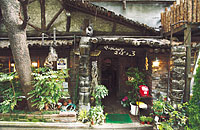Bon Appetit! Japanese Culture in the Kitchen
Cuisine from the West and other parts of the world has made inroads in the Japanese kitchen. But the Japanese tend to change things a bit to suit their taste preferences, creating some unique crossover recipes. There are, for example, kare raisu (curry and rice), korokke (croquette), and omuraisu (fried seasoned rice wrapped in a thin omelet). These pages introduce a Western/Japanese hybrid called spaghetti napolitan.
Close to the heart of Tokyo is the Jimbocho district. Nestled in among the shops selling old books is a nice spot to eat, called Sabor (Spanish for “taste”). Sabor serves the type of light meals you will find in a kissaten coffee shop, and during the lunch hour the place is often crowded with students and office workers. Many come for the spaghetti napolitan. The spaghetti, a little on the thick side, is boiled and then fried lightly with small pieces of ham, onion, green pepper and mushrooms. It has a nice tomato color. Sabor first opened its doors in 1955, and spaghetti napolitan has been a popular item on the menu since Day 1. On some days, as many as 200 customers ask for it.
The ingredients and recipe differ a little from chef to chef, but one ingredient that is always present is ketchup. Sabor’s cook fries the spaghetti and chopped ingredients, then stirs in a sauce made from a boiled mix of flavorful vegetables, ketchup and tomato purée. When it is ready for the table, on goes a sprinkling of Tabasco pepper sauce and powdered cheese. The spicy pepper and thick cheese flavor bring out the sweet tang of the thick ketchup sauce coating the soft spaghetti.
Soft spaghetti and ketchup—hardly a typical Italian pasta dish, you might say, and you would be right. The recipe comes not from Naples but from Yokohama, Japan.
Very soon after World War II, a chef at a Yokohama hotel came up with the idea of frying boiled spaghetti with tomato sauce and bits of food like ham and green pepper. Tomato sauce is said to have come originally from the Italian city of Naples, and that explains the name, spaghetti napolitan. It could be that, when the recipe spread to ordinary restaurants, it became common to add the ketchup. It is a fairly easy meal to make, and it quickly caught on as a light meal in kissaten coffee shops, and in the home.
Authentic Italian cuisine made its appearance in Japan beginning around the 1970s, and the Japanese have come to appreciate the real thing. But they have certainly not turned their backs on that upstart, spaghetti napolitan. The middle-aged and older keep coming back to it, year after year, and the younger generations see it as one meal option in convenience stores, ready-to-eat, packed in a plastic container. Few Japanese can resist the ketchupy flavor—it whets their appetite and reminds them of the good times they have had, eating this not-from-Naples pasta. ![]()
